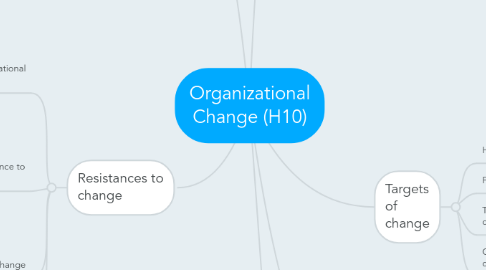
1. Resistances to change
1.1. Organizational inertia
1.2. Organizational-level resistance to change
1.2.1. Power and conflict
1.2.2. Differences in functional orientation
1.2.3. Mechanistic structure
1.2.4. Organizational culture
1.3. Group-level resistance to change
1.4. Individual-level resistance to change
2. Lewin's Force-field theory
2.1. Forces are balanced? inertia and no change
2.2. Want change? Increase forces and/or reduce resistance
2.3. 1. unfreeze 2. make change 3. refreeze
2.4. Action research is a strategy for generating and acquiring knowledge thaat managers can use to define an organization's desired future state and a plan to reach that state
2.4.1. 1. Diagnosing the organization
2.4.2. 2. Determining the desired future state
2.4.3. 3. Implementing action
2.4.3.1. External change agents
2.4.3.2. Internal change agents
2.4.3.3. Top-down change
2.4.3.4. Bottom-up change
2.4.4. 4. Evaluating the action
2.4.5. 5. Institutionalizing action research
3. Types of change
3.1. Evolutionary change
3.1.1. Gradual, incremental and narrowly focused
3.1.2. 3 instruments: Sociotechnical systems theory, total quality management and creation of fexible work groups
3.1.2.1. Sociotechnical systems theory proposes the importance of changing role/task to increase effectiveness
3.1.2.2. Total quality management developed to improve effectiveness of flexible work teams
3.1.2.2.1. Quality circles are groups of workers who discuss regulary to increase performance
3.1.2.3. Flexible work team is a group of workers who assume responsibility for completing a specific stage in the process
3.2. Revolutionary change
3.2.1. Rapid, dramatic and broadly focused
3.2.2. 3 instruments: Reengineering, restructuring and innovation
3.2.2.1. Reengineering refers to the process by which managers redesign how tasks are buncled into roles and functions
3.2.2.1.1. Buisiness process
3.2.2.1.2. E-Engeneering
3.2.2.2. Restructuring is a process by which managers change task and authority relationships and redesign organizational structure and culture
3.2.2.2.1. Downsizing is a process by which managers streamline the organizational hierarchy and lay off managers and workers to reduce bureaucratic costs
3.2.2.3. Innovation is the process by which organizations use their skills and resources to develop new goods and services/new production and operating systems to better respond to customers
4. Targets of change
4.1. Human resources
4.2. Functional resources
4.3. Technological capabilities
4.4. Organizational capabilities
5. Forces of change
5.1. Competitive forces
5.2. Economic forces
5.3. Political forces
5.4. Global forces
5.5. Demographic forces
5.6. Social forces
5.7. Ethical forces
6. Organizational development
6.1. A series of techniques and methods that managers can use in their action research program to increase adaptability
6.2. Techniques to deal with resistance
6.2.1. Education and communication
6.2.2. Participation and Empowerment
6.2.3. Facilitation
6.2.4. Bargaining and negotiation
6.2.5. Coercion
6.3. Techniques to promote change
6.3.1. Counseling, sensitivity training and process consultation
6.3.1.1. Sensitivity training consists of intense counseling in which group members, aided by a facilitator, learn how others perceive them and learn how to deal with others sensitively
6.3.1.2. Process consultation is a technique in which a falicitator works closely with a manager to help the manager improve their interactions with others
6.3.2. Team building and intergroup training
6.3.2.1. Team building is a technique in which a facilitator observes the interactions of group members and then helps them become aware of ways to improve
6.3.2.2. Intergroup training uses team building to improve the work interactions of different functions or divisions
6.3.2.3. Organizational mirroring is a technique in which a facilitator helps two interdependent groups to explore their perceptions and relations in order to improve their work interactions
6.3.3. Total organizational interventions
6.3.3.1. Organizational confrontation meetings bring together all of the managers to confront the issue of whether the organization is meeting its goals effectively
